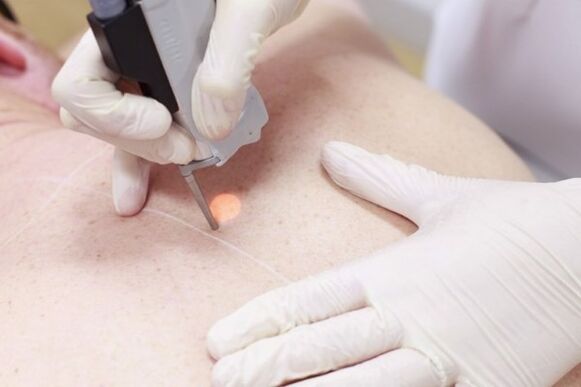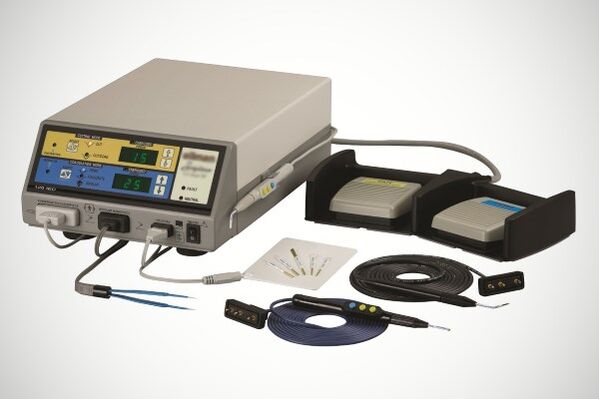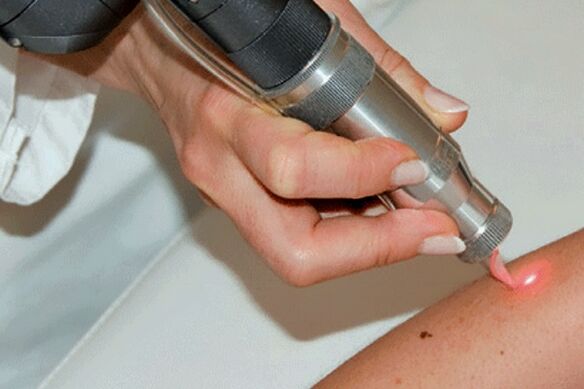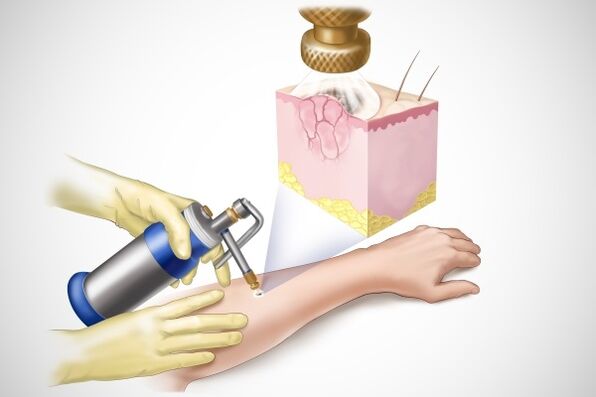After the appearance of growths on the body, patients almost never ask whether it is necessary to remove papillomas on the body. The answer is already clear, because they spoil a person's appearance and can degenerate into cancer. That is why most patients who have warts on their body are worried about it and wonder how to remove the papilloma and get rid of the papillomavirus?
To date, there are various ways to remove papillomas. They are divided into aesthetic procedures and surgical operations.The choice of method in any case depends entirely on the size of the papilloma, as well as on the strain of the virus that provoked the growth of the neoplasm.And the attending physician must choose a method for removing growths after conducting various studies and evaluating the dynamics of the pathological process. Before removing papillomas from the body, the patient must undergo a PCR study. It will show whether there are oncogenic viruses in the patient's body or not.

Electrocoagulation
Electrocautery is a procedure that allows you to quickly get rid of growths. During its implementation, the surgeon cauterizes neoplasms with high-frequency current. The main advantages of electrocoagulation include the fact that the doctor can control the depth of exposure and reduce even the largest neoplasms.
Under the influence of high-frequency current, the proteins in the neoplasm coagulate and the warts begin to collapse. It is important to say that electrocoagulation increases the chances of getting rid of it once and for all, because this procedure indirectly eliminates the causes of the disease - the vessels that feed the neoplasm are damaged.
With electrocoagulation, tissue infection is excluded and the risk of bleeding is significantly reduced.
During electrocoagulation, the patient may experience pain, therefore, before removing the papilloma from the body in this way, the doctor gives the patient local anesthesia. Having learned all the advantages of electrocoagulation, people no longer doubt whether it is necessary to remove papillomas.

Radio wave wart removal
Removal of papillomas with radio waves is a procedure during which a specialist performs an atraumatic cut of the neoplasm and then destroys it. In this case, soft tissue coagulation occurs.
Is it dangerous to remove papillomas in this way? Absolutely not. Recently, this procedure has become very popular. This is one of the most accurate methods for removing growths. It never affects healthy, virus-free tissue. After the radio wave treatment, there are no signs or marks on the body, there are not even slight signs of burns.
At the moment, these manipulations are carried out using a radio wave apparatus. It is highly effective and completely safe. People call it a radio knife. This device converts electric current into radio waves and breaks down the pathological areas with the help of the heat they themselves produce.
This device is used in gynecological practice, it helps to get rid of genital warts and cervical dysplasia. A radio knife can be used to treat very young girls and adults who have given birth to women. Before removal of papillomas, a woman should undergo a biopsy.

Laser treatment of warts
Laser treatment of papillomas is one of the most modern and popular methods for removing growths at the moment. During this procedure, the doctor directs a laser at the wart, as a result of which it begins to heat up strongly and eventually evaporates.
As with electrocoagulation during laser treatment, the damaged vessels are sealed, as a result of which the risk of bleeding, infection and inflammation is significantly reduced and the rehabilitation period is reduced. After laser wart removal, scars or marks do not remain on the skin.
This procedure can cause pain, therefore, before removing papillomas in this way, doctors give the patient local anesthesia. Before removing papillomas from the body, the doctor applies an anesthetic (cream or spray).
Rehabilitation after such a procedure lasts from 5 to 8 days (depending on the size of the neoplasm and the individual characteristics of the organism).
The laser, as well as the radioknife, can be used by gynecologists to reduce genital warts, to eliminate dysplasia of the cervical epithelium.
Before removing the papillomas from your body permanently, the patient must also undergo a colposcopy. Before treatment, women are not given local anesthesia. This is due to the fact that there are no nerve endings in the cervix. You should ask your doctor how quickly the procedure will pass in a particular case.

It is worth saying that this method is also suitable for women who have not given birth, because the laser can completely destroy the pathological focus and at the same time will never provoke thickening of the cervical tissues. Do not perform laser treatment during menstruation. After the advent of this technique, people stopped being afraid of papillomas. How to get rid of them became clear to everyone.
Elimination of growths with liquid nitrogen
Cryosurgery is a procedure in which a specialist applies liquid nitrogen to the warts. This leads to the fact that the neoplasm is cooled to a temperature of -196 degrees. Removal of papillomas by means of cryodestruction provokes the formation of ice crystals in the tumor and metabolic disorders in it.
Is it possible to remove papillomas at home? Yes. To do this, you need to buy a special bag for cryodestruction in a pharmacy. How to remove papillomas on the body yourself is written in the instructions. The procedure is absolutely painless and therefore does not require the introduction of anesthetics.
During cryodestruction, the specialist immerses a special applicator in liquid nitrogen, after which he applies it to the papilloma. After some time, the wart begins to turn black and eventually disappears on its own.
The disadvantages of cryodestruction include its not very high efficiency. So, with large extensive skin lesions, to get rid of papillomas on the body, several procedures are needed. In addition, in the process of removing the papilloma, the doctor cannot fully control the depth of exposure. It is for this reason that large warts may require several treatments. At the same time, if you remove small warts, the effect of liquid nitrogen can be very deep, as a result of which scars will remain on the body.

Surgical excision of a neoplasm
In this case, the papilloma is simply cut with a scalpel. Before removing papillomas from the patient's body in this way, the doctor gives the patient anesthesia. At the end of the operation, a narrow sterile bandage is applied to the wound.
Does it hurt to remove papillomas in this way? Yes, so doctors had to switch almost completely to using other methods. Today, a more modern version of surgical treatment is available, which allows the removal of papillomas on the body with a laser scalpel. The advantage of this method is that the risk of bleeding and infection is reduced for the patient (the laser closes the damaged vessels).
This procedure is considered less traumatic, but at the same time allows you to remove neoplasms of any shape, size and at any depth.
Chemical cauterization of the wart
Chemical cauterization of papillomas is a good way to get rid of HPV. This is a procedure in which the doctor applies a drug that destroys HPV on the surface of the tumor, which causes the process of necrosis in the wart. After the procedure, a crust is formed at the site of the papilloma, which falls off the body after a few days.
It is impossible to tear or scratch this crust, as in the future this can lead to the formation of severe wounds. Before removing papillomas from the body with this method, the doctor performs anesthesia.

If there are papillomas on the body, is it possible to remove them yourself?
Chemical cauterization of the papilloma requires high professionalism, therefore the removal of the papilloma on the body should be carried out only in medical institutions. Only the doctor knows which drugs to choose for the treatment of the patient in a particular case. For example, to eliminate common or plantar warts, it is better to use drugs based on salicylic acid, and to remove filiform neoplasms or genital warts, it is better to use the extract of Spanish flies. To eliminate neoplasms in the intimate area, a drug with podophyllotoxin and an acid-based agent is used.
If it is not possible to cauterize the papilloma by applying a chemical solution to it, the doctor may recommend introducing a cytostatic glycopeptide antibiotic directly into the lesion itself.
Disease prognosis
After performing any modern procedure for the removal of neoplasms, papillomas disappear completely. However, the removal of papillomas is only the elimination of the symptoms of the disease, the reason itself (low immunity and, as a result, a high concentration of the virus) still remains. Therefore, after the growths are removed, patients are prescribed antiviral and immunostimulant drugs.
It is best to remove papillomas when it is summer or winter outside, as the weather is often wet in autumn and spring, which will prevent the healing of the wounds.
How to get rid of papilloma is already clear, but how to keep this effect? It is important to say that it is completely impossible to get rid of the human papillomavirus. Even after completing the full course of treatment, the risk of recurrence of the pathology remains forever. To avoid the recurrence of the disease, it is recommended to strengthen the body: harden, play sports, have more time to relax and be in the fresh air, lead a proper lifestyle, eat a healthy dietbalanced and to get complexes of vitamins and minerals. .
If neoplasms reappear, you should consult a specialist. He knows why papillomas appeared and how the patient can get rid of them forever. He will also be able to tell if the warts need to be removed in a particular case.


















